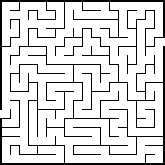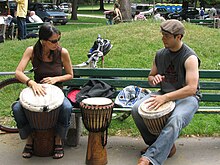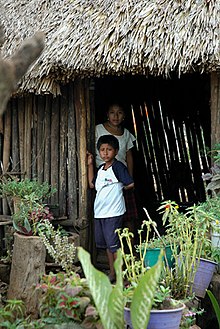
Albert Bandura was a Canadian-American psychologist. He was a professor of social science in psychology at Stanford University.
Social learning is a theory of learning process social behavior which proposes that new behaviors can be acquired by observing and imitating others. It states that learning is a cognitive process that takes place in a social context and can occur purely through observation or direct instruction, even in the absence of motor reproduction or direct reinforcement. In addition to the observation of behavior, learning also occurs through the observation of rewards and punishments, a process known as vicarious reinforcement. When a particular behavior is rewarded regularly, it will most likely persist; conversely, if a particular behavior is constantly punished, it will most likely desist. The theory expands on traditional behavioral theories, in which behavior is governed solely by reinforcements, by placing emphasis on the important roles of various internal processes in the learning individual.

The Bobo doll experiment is the collective name for a series of experiments performed by psychologist Albert Bandura to test his social learning theory. Between 1961 and 1963, he studied children's behaviour after watching an adult model act aggressively towards a Bobo doll. The most notable variation of the experiment measured the children's behavior after seeing the adult model rewarded, punished, or experience no consequence for physically abusing the Bobo doll.

Imitation is a behavior whereby an individual observes and replicates another's behavior. Imitation is also a form of that leads to the "development of traditions, and ultimately our culture. It allows for the transfer of information between individuals and down generations without the need for genetic inheritance." The word imitation can be applied in many contexts, ranging from animal training to politics. The term generally refers to conscious behavior; subconscious imitation is termed mirroring.
Collaborative learning is a situation in which two or more people learn or attempt to learn something together. Unlike individual learning, people engaged in collaborative learning capitalize on one another's resources and skills. More specifically, collaborative learning is based on the model that knowledge can be created within a population where members actively interact by sharing experiences and take on asymmetric roles. Put differently, collaborative learning refers to methodologies and environments in which learners engage in a common task where each individual depends on and is accountable to each other. These include both face-to-face conversations and computer discussions. Methods for examining collaborative learning processes include conversation analysis and statistical discourse analysis.
Youth participation is the active engagement of young people throughout their own communities. It is often used as a shorthand for youth participation in any many forms, including decision-making, sports, schools and any activity where young people are not historically engaged.

Latent learning is the subconscious retention of information without reinforcement or motivation. In latent learning, one changes behavior only when there is sufficient motivation later than when they subconsciously retained the information.
Cognitive imitation is a form of social learning, and a subtype of imitation. Cognitive imitation is contrasted with motor and vocal or oral imitation. As with all forms of imitation, cognitive imitation involves learning and copying specific rules or responses done by another. The principal difference between motor and cognitive imitation is the type of rule that is learned and copied by the observer. So, whereas in the typical imitation learning experiment subjects must copy novel actions on objects or novel sequences of specific actions, in a novel cognitive imitation paradigm subjects have to copy novel rules, independently of specific actions or movement patterns.
On-the-job training is an important topic of human resource management. It helps develop the career of the individual and the prosperous growth of the organization. On-the-job training is a form of training provided at the workplace. During the training, employees are familiarized with the working environment they will become part of. Employees also get a hands-on experience using machinery, equipment, tools, materials, etc. Part of on-the-job training is to face the challenges that occur during the performance of the job. An experienced employee or a manager are executing the role of the mentor who through written, or verbal instructions and demonstrations are passing on his/her knowledge and company-specific skills to the new employee. Executing the training on at the job location, rather than the classroom, creates a stress-free environment for the employees. On-the-job training is the most popular method of training not only in the United States but in most of the developed countries, such as the United Kingdom, Canada, Australia, etc. Its effectiveness is based on the use of existing workplace tools, machines, documents and equipment, and the knowledge of specialists who are working in this field. On-the-job training is easy to arrange and manage and it simplifies the process of adapting to the new workplace. On-the-job training is highly used for practical tasks. It is inexpensive, and it doesn't require special equipment that is normally used for a specific job. Upon satisfaction of completion of the training, the employer is expected to retain participants as regular employees.
Social learning is learning that takes place at a wider scale than individual or group learning, up to a societal scale, through social interaction between peers.
Animal culture can be defined as the ability of non-human animals to learn and transmit behaviors through processes of social or cultural learning. Culture is increasingly seen as a process, involving the social transmittance of behavior among peers and between generations. It can involve the transmission of novel behaviors or regional variations that are independent of genetic or ecological factors.
Social cognitive theory (SCT), used in psychology, education, and communication, holds that portions of an individual's knowledge acquisition can be directly related to observing others within the context of social interactions, experiences, and outside media influences. This theory was advanced by Albert Bandura as an extension of his social learning theory. The theory states that when people observe a model performing a behavior and the consequences of that behavior, they remember the sequence of events and use this information to guide subsequent behaviors. Observing a model can also prompt the viewer to engage in behavior they already learned. Depending on whether people are rewarded or punished for their behavior and the outcome of the behavior, the observer may choose to replicate behavior modeled. Media provides models for a vast array of people in many different environmental settings.

Informal learning is characterized "by a low degree of planning and organizing in terms of the learning context, learning support, learning time, and learning objectives". It differs from formal learning, non-formal learning, and self-regulated learning, because it has no set objective in terms of learning outcomes, but an intent to act from the learner's standpoint. Typical mechanisms of informal learning include trial and error or learning-by-doing, modeling, feedback, and reflection. For learners this includes heuristic language building, socialization, enculturation, and play. Informal learning is a pervasive ongoing phenomenon of learning via participation or learning via knowledge creation, in contrast with the traditional view of teacher-centered learning via knowledge acquisition. Estimates suggest that about 70-90 percent of adult learning takes place informally and outside educational institutions.
Modeling is:
- a method used in certain cognitive-behavioral techniques of psychotherapy whereby the client learns by imitation alone, without any specific verbal direction by the therapist, and
- a general process in which persons serve as models for others, exhibiting the behavior to be imitated by the others This process is most commonly discussed with respect to children.
In emulation learning, subjects learn about parts of their environment and use this to achieve their own goals and is an observational learning mechanism.
Behavioral contagion is a form of social contagion involving the spread of behavior through a group. It refers to the propensity for a person to copy a certain behavior of others who are either in the vicinity, or whom they have been exposed to. The term was originally used by Gustave Le Bon in his 1895 work The Crowd: A Study of the Popular Mind to explain undesirable aspects of behavior of people in crowds. In the digital age, behavioral contagion is also concerned with the spread of online behavior and information. A variety of behavioral contagion mechanisms were incorporated in models of collective human behavior.
Imitative learning is a type of social learning whereby new behaviors are acquired via imitation. Imitation aids in communication, social interaction, and the ability to modulate one's emotions to account for the emotions of others, and is "essential for healthy sensorimotor development and social functioning". The ability to match one's actions to those observed in others occurs in humans and animals; imitative learning plays an important role in humans in cultural development. Imitative learning is different from observational learning in that it requires a duplication of the behaviour exhibited by the model, whereas observational learning can occur when the learner observes an unwanted behaviour and its subsequent consequences and as a result learns to avoid that behaviour.
Social learning refers to learning that is facilitated by observation of, or interaction with, another animal or its products. Social learning has been observed in a variety of animal taxa, such as insects, fish, birds, reptiles, amphibians and mammals.
Child work in indigenous American cultures covers child work, defined as the physical and mental contributions by children towards achieving a personal or communal goal, in Indigenous American societies. As a form of prosocial behavior, children's work is often a vital contribution towards community productivity and typically involves non-exploitative motivations for children's engagement in work activities. Activities can range from domestic household chores to participation in family and community endeavors. Inge Bolin notes that children's work can blur the boundaries between learning, play, and work in a form of productive interaction between children and adults. Such activities do not have to be mutually exclusive.

Styles of children’s learning across various indigenous communities in the Americas have been practiced for centuries prior to European colonization and persist today. Despite extensive anthropological research, efforts made towards studying children’s learning and development in Indigenous communities of the Americas as its own discipline within Developmental Psychology, has remained rudimentary. However, studies that have been conducted reveal several larger thematic commonalities, which create a paradigm of children’s learning that is fundamentally consistent across differing cultural communities.










